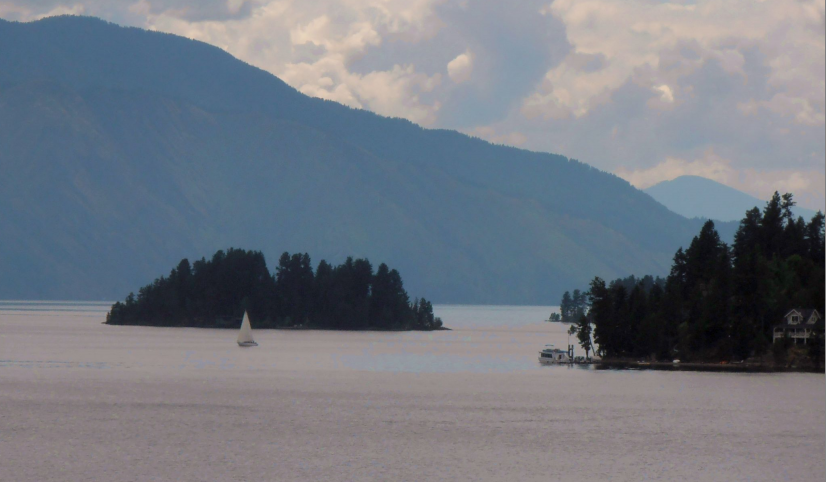April 2019
 One of the things we human beings seem to do best is take things for granted. Our attention span is miniscule in the scope of the wide world. We forget what we’re about as soon as some other bright, shiny object crosses our field of vision. That tendency is at diametric opposites with the reality and processes of geology. In geological reality a human lifespan doesn’t even show up on the clock. So no wonder we’re never up close and personal with the geology all around us unless it stands out so blatantly that just looking at it becomes a Big Deal — take Angel Falls in Venezuela as a case in point. That’s a piece of geology with star quality if ever there was one. But it’s the exception, not the rule. All of geology matters to us, so I’ve tried to pull geology into the texture of daily life because we live on it, with it, and through it every day.
One of the things we human beings seem to do best is take things for granted. Our attention span is miniscule in the scope of the wide world. We forget what we’re about as soon as some other bright, shiny object crosses our field of vision. That tendency is at diametric opposites with the reality and processes of geology. In geological reality a human lifespan doesn’t even show up on the clock. So no wonder we’re never up close and personal with the geology all around us unless it stands out so blatantly that just looking at it becomes a Big Deal — take Angel Falls in Venezuela as a case in point. That’s a piece of geology with star quality if ever there was one. But it’s the exception, not the rule. All of geology matters to us, so I’ve tried to pull geology into the texture of daily life because we live on it, with it, and through it every day.
All of us are literally the stuff of the Earth in the same way rocks and plants and everything else is on the Planet that’s composed of matter. Our biology depends on the same chemistry and quantum mechanics that make minerals what they are. Geology makes the soil in which we grow our food. Geology provides us with the stuff we dig out of the ground to make so many of the things we use in daily life. We’re all in this together, so let’s give credit where credit is due and recognize that the geology of the Planet is a far bigger deal than we humans are. It can get along without us, but without the many resources it provides to us we’d be sunk in a heartbeat. Geology is king when you come down to the brass tacks of the matter that is matter. It behooves us to keep that fact in mind.
I say that without any scientific background to influence my opinion. Not only am I not a degreed geologist, I’ve never even taken a formal course in geology. I came to the subject as a rank amateur and found my way forward in it by following my nose. That approach was best for me as the member of the Great Unwashed that I am. Science, as we all know, is decidedly a guy thing. Guys run it and set the tone for it. Even today gals who do science have to pass muster on guy criteria or they get run out of Dodge. That circumstance is unfortunate since guys have a lamentable tendency to make things more complicated and far duller than their reality warrants. All too often they’re like dogs worrying bones, trying to prove a point to shore up that fragile male ego. Since women don’t have a male ego to defend and continue with the business at hand blithely unconcerned about the size of anything between their legs, they usually approach things much more sensibly. As misfortune would have it, geology is at the top of the list of guy-dominated branches of science. The guy effects on the literature of the discipline are predictable. Rebecca West makes a germane point in a piece she wrote for The Freewoman in 1912 when reviewing a book by E. Belfort Bax:
Problems of Men, Mind and Morals is further evidence of the fact which the Labour Party proved long ago — that when a socialist takes to being dull, he is much duller than anybody else. Tariff Reformers do amusing tricks with loaves, and Ulstermen call most entertainingly on the name of God, but there is no comic relief about socialists.
The same can be said about geologists, I fear. Apologies to the peanut gallery.
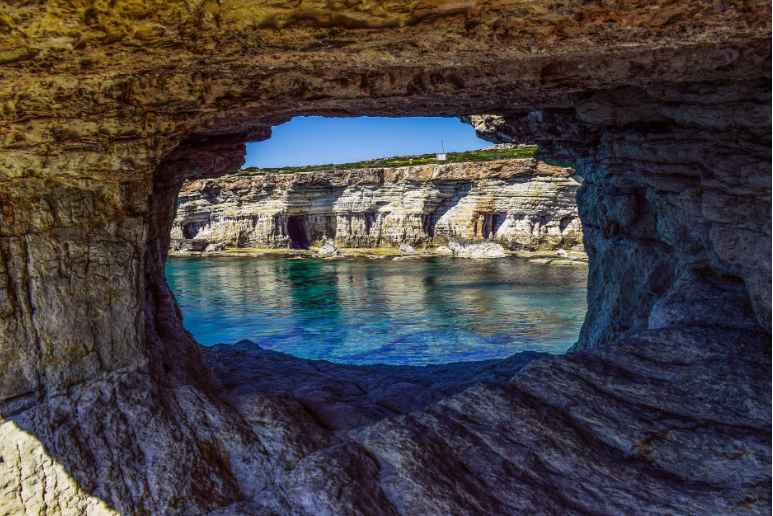
Being a rank amateur eliminates any pressure on me to conform to such folderol. I may form opinions as I choose, infuse my research with subjective elements like curiosity and wonderment and jump the guardrails of professional circumspection into flights of geologic fancy whenever the spirit so moves me. The impulses that brought me to the discipline would in fact strike a professional geologist as thoroughly undignified and likely suspect on grounds of gender identity. It’s obvious that I’d never be admitted to the Guy Geologist Club. But no matter, I’m in it for the fun, so the pros are useful to me only for their informational value. I run roughshod over their professional conventions without a moment’s hesitation, just as I discard so many other conventions that prove damping to the human spirit.
In 2011 I returned after many years of absence to the area of the USA where I grew up. My family owns a couple hundred acres there spread over mountainous terrain. Going in a straight line in any direction inevitably means going up hill or down dale. One day while standing on the top of a mountain I’ve hiked up and down since my childhood it occurred to me that I knew nothing about the mountain itself. Where did it come from? What’s it made of? How old is it? It’s a mountain I’ve loved all my life, how could I be so remiss as to remain ignorant of its life story? Then and there I decided I’d get to know that mountain and its fellows all around so I could better appreciate their reality, a reality once again up close and personal to me. Thus began my delvings into geology, guided by the Ariadne’s thread of affection for the landscape I inhabited once again after long absence.
Since I was free from any constraints of a formal syllabus I jumped in with both feet and let serendipity guide my steps as I began amassing and absorbing information. The Internet is the jewel in the crown of independent researchers like myself and my gratitude for the range of information available now is continuous. As always when I do research one things leads to another — not necessarily in a strictly logical order. It’s much more like grabbing a shopping cart in a supermarket, running up and down the aisles and throwing in things that look good even if you don’t need them right at the moment. You can never have that info larder too full, right? Right. Here’s a sample of my geology stash:
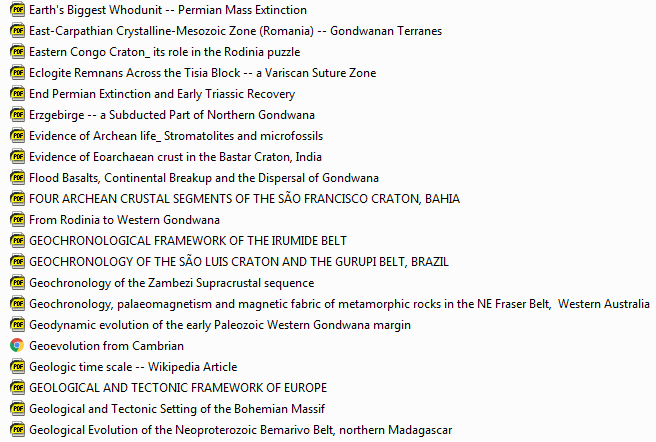
At present I have 481 files in 25 folders. But don’t stop counting, the tally continues to mount. Looking over the list you might think I lack focus since my stated objective was to learn more about the mountain in my own neck of the woods. Well, my old stomping ground happens to be on the edge of a continental craton with accretion terranes stretching all the way over to the Pacific Ocean some 400 miles away. Part of those accreted terranes used to be where Australia now sits. Yes, Bridget, I kid you not. Things that look solid as houses move around in the most astonishing ways. In order to understand my mountain I need to understand what has moved where and what bits have stuck to other bits. If that piece of Australia hadn’t bashed into the edge of the North American craton in the Miocene (info here) my mountain would never have come to be since it’s part of a granitic pluton emplaced by the collision. I was gobsmacked to think of a piece of crust at the other end of the globe coming all the way to the Pacific Northwest to hit our craton and deform like a piece of bread dough thrown against a wall. It’s terribly exciting stuff and motivation for many hours of research and reading. If you think I’m making up stories you can have a dip into the literature for yourself. Just don’t expect it to read like a suspense novel. Our geologist friends manage to bleed all the surprise and excitement out of a story that otherwise would keep you on the edge of your seat dying to find out what happens next.
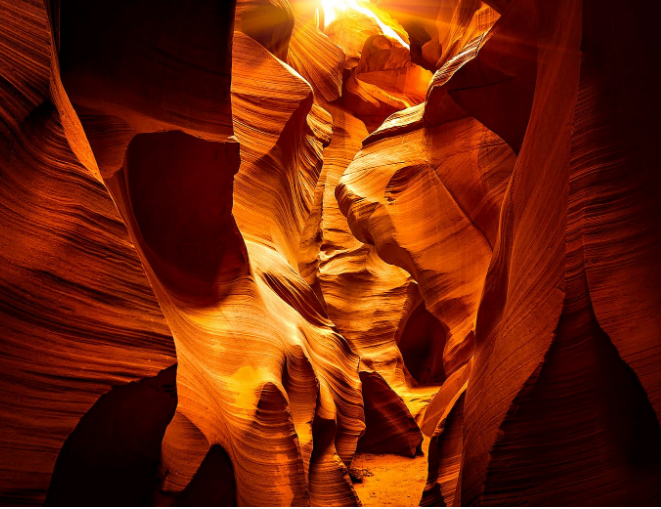
There were such surprises in store for me, I had no idea. It turns out that the edge of a continental craton is a very happening place and there had been all kinds of wild tectonic parties in the past, some of them so wild that in this day and age somebody would surely call the police. My mountain was created in a spate of vulcanism that raised a large granite pluton. The composition of the granite is telltale for that sort of event. Since it happened in the Miocene it’s a recent event in geologic terms. Little did I know standing on top of my mountain that day I decided to get better acquainted with it that we have something in common: we’re both new kids on the block, one of us biologically and the other geologically speaking. We’re the young and the restless. Don’t hate us ’cause you ain’t us. 🙂
Not far away, however, the story is shockingly different. When I discovered that fact it stopped me dead in my tracks. The article that made my head explode has the title: “Geology and U-Pb geochronology of Archean basement and Proterozoic cover in the Priest River complex, northwestern United States, and their implications for Cordilleran structure and Precambrian continent reconstruction.” Here’s the abstract — I leave it to you to find the article on Researchgate if you’re so motivated (but I’m not holding my breath so don’t worry LOL):
Precambrian basement rocks exposed within tectonic windows in the North American Cordillera help to define the Precambrian crustal structure of western North America and possible reconstructions of the Late Proterozoic supercontinent Rodinia. New geologic mapping and U-Pb dating in the infrastructure of the Priest River metamorphic complex, northern Idaho, documents the first Archean basement (2651 +/- 20 Ma) north of the Snake River Plain in the North American Cordillera. The Archean rocks are exposed in the core of an antiform and mantled by a metaquartzite that may represent the nonconformity between basement and the overlying Hauser Lake gneiss, which is correlated with the Prichard Formation of the Belt Supergroup. A structurally higher sheet of augen gneiss interleaved with the Hauser Lake gneiss yields a U-Pb zircon crystallization age somewhat greater than 1577 Ma. The slivers of augen gneiss were tectonically interleaved with the surrounding Hauser Lake gneiss near the base of the Spokane dome mylonite zone, which arches across this part of the Priest River complex. We conclude that the Spokane dome mylonite zone lies above the Archean basement-cover contact and that it was, in part, equivalent to the basal decollement of the Rocky Mountain fold and thrust belt. New U-Pb dates on metamorphic monazite and xenotime reveal peak metamorphism at ca. 72 Ma, compatible with movement along the Spokane dome mylonite zone at that time. The Archean basement could be interpreted as the western extension of the Hearne province, or a new Archean basement terrane separated from the Hearne province by an Early Proterozoic suture. The unique assemblage of 2.65 Ga basement, similar to 1.58 Ga felsic intrusive rocks, and the Middle Proterozoic Belt Supergroup can be used as a piercing point for the identification of the conjugate margin to Laurentia. Our new dating supports previous correlations of Australia’s Gawler craton (2.55-2.65 Ga) and its 1590 Ma plutons with the Priest River complex basement gneisses. The Priest River complex basement may be a piece of eastern Australia stranded during rifting of the supercontinent Rodina in the Late Proterozoic.
You can see why I cited Rebecca West earlier. The language reminds one of a puppy chasing its tail. Here’s a different take on the title: “There’s Some REALLY COOL Old Rocks Near Priest River That Go Back To When the Earth Was Still In Its Infancy.” That’s the jist of it. The Archean Eon spans 4-2.5 billion years ago. So the Archean basement discussed in the article is seriously old rock. Terribly exciting stuff and it made perfect sense to me. Why? For no reason to which a geologist would ever lend credence, but fear not: I’m not a geologist.
The area discussed is about a half-hour’s drive away from my neck of the woods. Priest River is chock full of Italians who came over from the Old Country back in the day to build railroads. Apparently the idea of working long days on a conscription gang in what at the time was the middle of nowhere (some say it still is LOL) appealed more than the idea of starving to death in Calabria or Basilicata. They’ve been around long enough now to be as American as apple pie but their names are a dead giveaway about where great-grampa came from. One of the scenic wonders of the area — and there are many — is Lake Pend Oreille, another half-hour down the road. Here’s a pic:
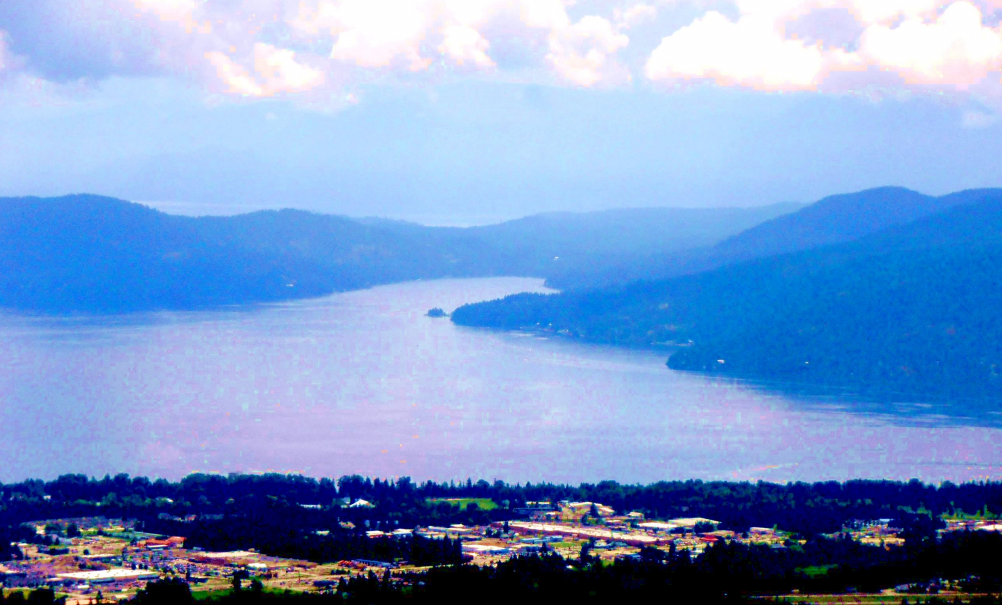
It’s HUGE and its geological backstory is such a madcap tale of glaciers, ice dams, catastrophic floods and other mayhem that it makes a John Grisham novel seem like the owner’s manual for a lawn mower. But let’s save that story for another day. When you drive from my neck of the woods to Lake Pend Oreille you go right through the area described in the article. The reason the article immediately made sense to me is that I’ve always known there’s something special there. The rocks are exposed to view because of the roadcuts made to put in the highway. They’re not granite like my mountain. They’re smooth and light-colored and show all manner of twisting and turning in the rockfaces exposed to the road. What’s more, they feel different. They feel very old. Since I’m not a geologist it’s perfectly acceptable for me to include impressionistic data in my geological assessments, even if I’m short on U-Pb (uranium and lead) isotope measurements. As soon as I read the article I said to myself, “So that’s why it feels so different there, now I get it.” So thanks for the helping hand, guys, even though you nearly bored my socks off. 🙂
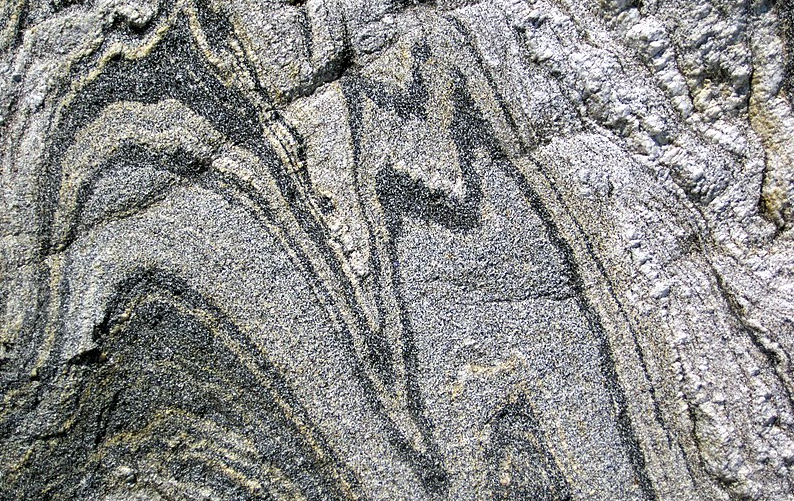
Building up geological knowledge about my neck of the woods changed my sense of it in good ways. It gave things their proper foundation. All the biological phenomena — including me — on the property came as afterthoughts to the geology and in many regards followed its leads. As I walked over our acreage I saw how dramatically the geology and topography determined the plant communities that flourish in the microenvironments the terrain creates with its rises and dips and folds. The contrasts within just a short distance can be enormous. Here, for example, is the microenvironment at the base of a mountain that channels water into the lowlands: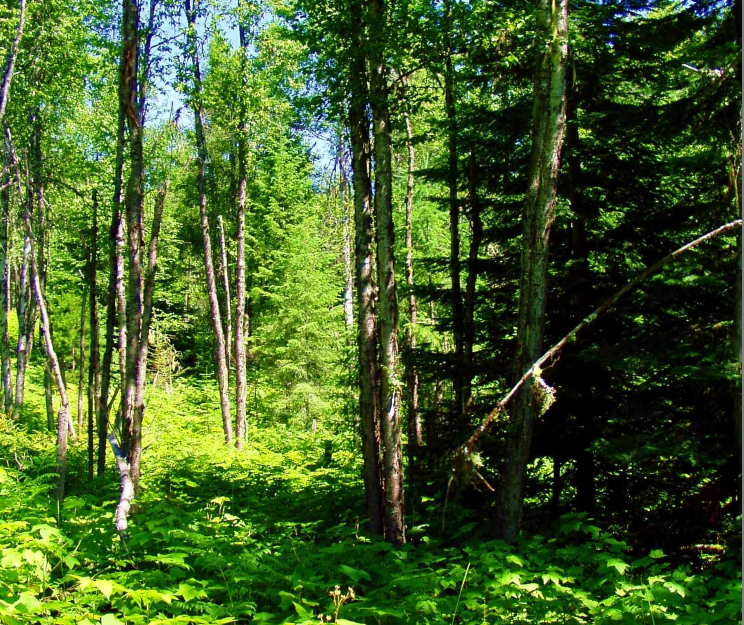
This is a forest type dependent on robust hydrology fairly close to the surface. The tree species tell the story — birches (Betula papyrifera) don’t grow where they have to go thirsty too often. The conifers in the mix also tell the tale since grand fir (Abies grandis) is quite happy having its feet wet, unlike Douglas fir (Pseudotsuga menziesii) or one of the pine species common in the area. A Ponderosa pine (Pinus ponderosa) wouldn’t be caught dead in such a place because if it were it would be dead in short order, it’s just too wet.
A short walk of 15 minutes from the spot in the picture above brings you to a completely different microenvironment and shows even more clearly the importance of geology in the scheme of things:

As you go up in height you see the vegetation become thinner and thinner. Granite doesn’t weather very fast and makes poor soil for our plant friends, so it’s a hard row to hoe to be a tree and grow on such a surface. The mix of conifers at the edge of the meadow shows the benefit of centuries of soil creation from weathering and runoff coming down from the mountain every spring when the snow melts, which sends water tumbling down the face of the granite slopes. As you can see, granite outcrops still abound on the hills on which nothing but lichens grow, save a few tufts of grass in the cracks and crevices where they find enough soil to eke out a living.
Granite outcrops are smoking guns in the matter of geological identification. Usually it’s a question of being cognizant of the larger scope of the geological goings-on and having a handle on the chemistry of the substrate rock in order to understand the soil types and associated plant communities you find as you move around. Because of how things work in my neck of the woods I can’t easily separate the geology from the plants, they’re too bound up with each other and I’d feel something missing if I limited my focus to just one or the other. This pic will make clear why that circumstance obtains:

People who live in the Southwest of the USA or in some other desert clime will be light years ahead of me in understanding what it means to live with bare-naked geology all around. I’ve only lived in one place where that opportunity afforded itself: Saudi Arabia.
Nothing would please me more than to wax poetic about my memories of fantastic landscapes in the part of Saudi Arabia I lived in for five years. No can do, sorry. I lived in Eastern Province near the Gulf coast where the geology is uniformly mudstone in remarkably uninspiring configurations. It’s great for finding oil reserves, don’t get me wrong. From the standpoint of landscape aesthetics, however, you’re up a creek without a paddle, to use as inappropriate a metaphor as I can imagine for that parched part of the Planet.
On the other side of the country, however, the story is completely different, as I described in another post entitled “The Mountains of Saudia Arabia.” I need to pull in that thread here, because that area taught me the truth about living with geology up close and personal without any riders-along like forests and wildflowers and streams. In the area of Tenomah in the middle portion of the Hijaz Range the human and geologic elements stand cheek by jowl. The geology dwarfs the humans quite entirely. Even a structure like an apartment building that would ordinarily impose becomes laughable in scale against its backdrop:

In my exploration of the area I came upon astonishing places where people had thought fit to plop themselves in the middle of an expanse of barrenness that would send me fleeing toward the nearest valley. Here are a couple examples:
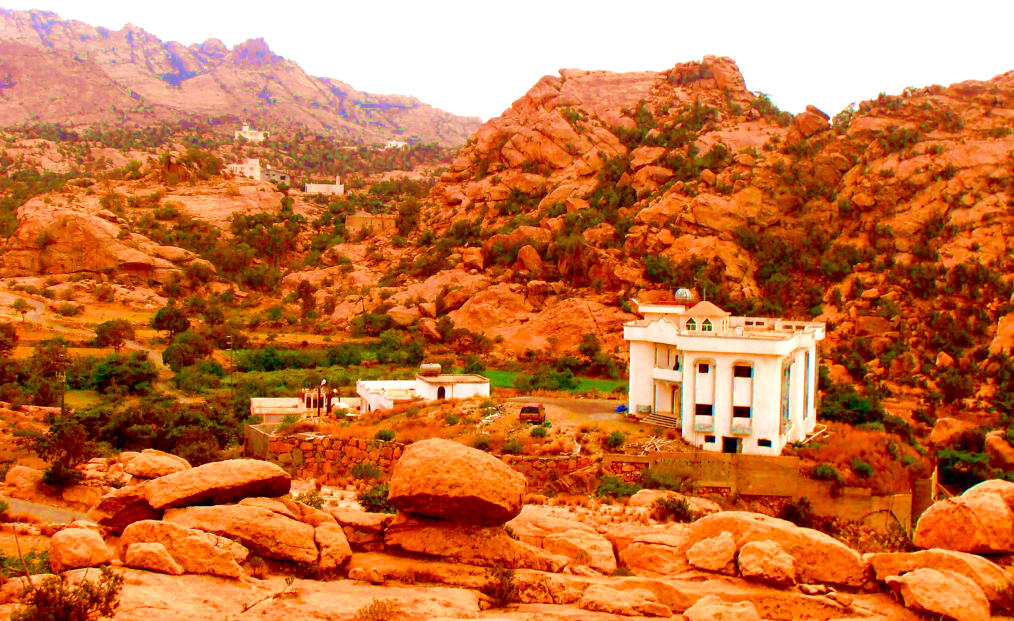
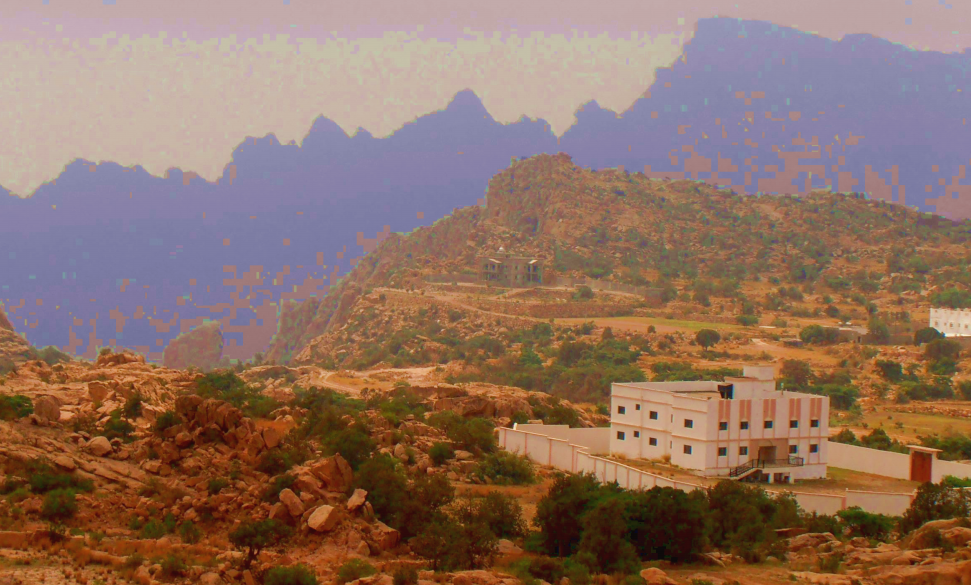
Obviously a situation of this kind calls for a completely different take on what geology means for daily life because it’s decidedly in the foreground, not the background. The time I spent in the area is the only time in my life where geology has been that close a bedfellow. Even that brief stint taught me an important lesson.
Geology is obviously foundational to terrestrial life. The way our skin of biosphere on the surface of the Planet’s crust operates claims all our attention for things other than the geology on which everything rides. Usually we’re busy thinking about people, of course — that’s the given of self-referentiality that binds us to all the other species of animal life we know. We don’t dig very deep even in our daily lives to get to the bedrock of things. Why expect us to do it with the natural environment?
But there’s a good reason to keep such things in mind. It’s called: dimensionality. It may seem a bit of a stretch but let’s consider the respective uses of geology and death: both are defining parameters in human life. We don’t think about either one very often but that doesn’t mean they don’t have great power over our lives as bottom lines of the categorical sort. Just as we don’t like thinking ahead to the Final Curtain Fall, we don’t bother to think about the geology we run around on all the time, despite its being a physical reality on which our lives depend fundamentally. So for me it’s important to keep geology front and center in my awareness in order to stay clear in my head about first principles, just as it’s important — now more than ever for someone of my age — to keep the fact of death in mind as a guideline for present action. Blithely to ignore the fact of either thing would be to live in delusion about the true nature of my personal reality. Facts is facts. Neither geology nor death can be rationalized away — no matter how much you think like an attorney general. 🙂
The environment in the Hijaz mountains of Saudi Arabia taught me that lesson: keep the bedrock truth in mind. When that truth is all up in your grill like it is in Tenomah it’s not hard to keep the beat. When you’re sitting in your living room watching the news and eating (non-peanut) M&Ms it’s easy to put it out of mind. The same goes for death. At least it used to be for me until I became a Golden Oldie, which put the kibosh on that little minuet. When the next decade marker you’re looking at starts with 7, pretending the “d” word doesn’t apply to you stops being believable. As well it should, since sooner or later the truth will out. Exactly the same thing can be said of the geology we live with. Just ask the folks who live on the San Andreas Fault or at the base of Vesuvius. 🙂
Wherever I am now I actively seek out whatever I can find about the geology of the place. It’s now as much a part of moving around the world as buying plane tickets. If I’m going to be walking on hills or in valleys in a part of the world I’ve never visited before, I want to know just what I’m walking on. The same feeling I had that day I stood on the top of my mountain follows me now wherever I go and urges me to acquire the same knowledge I gained for the hills and valleys I know in my own neck of the woods.
The dimensionality such knowledge adds to one’s experience of a place is astonishing — it fleshes it out in a way I’d never have thought possible before I took on the task of geological literacy. That state of awareness has everything to recommend itself because the greater the point of your consciousness, the more reality you can perceive. My goal, of course, is omniscience — I’m giving it the old college try, but don’t hold your breath LOL.
So for me living with the geology around me has become just another facet of living well. I’m grateful to all the deadly boring geologists who’ve helped me along this path to greater awareness — bless ’em, they’re doing the best they can. The geology itself is exciting and often brings me a “wow!” moment. So let’s have a big round of applause for our rock friends. They’re always at the party and oh boy do they have great stories to tell!
